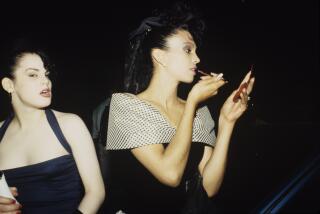TV Reveiws : ‘Carmen Miranda’ Looks Behind Image
- Share via
Even if you were a child during World War II, you could never forget singing and dancing star Carmen Miranda, the “Brazilian Bombshell” who did so much to cheer audiences everywhere with her outrageous costumes, sparkling eyes, vivacious personality and amusing accent.
At that time, in the last full decade of Hollywood’s Golden Age, Miranda was surely thought of, by and large, solely as an amusing entertainer and comedian. Later on she became a camp figure, emulated by drag queens, and more recently she has been taken seriously as an artist who, in her prime, symbolized not only Brazil but also South America.
Brazilian documentarians Helena Solberg’s perceptive, poignant “Carmen Miranda: Bananas Is My Business” continues this probe to discover the woman behind the gaudy image.
Solberg was both persistent and fortunate: She came up with revealing archival materials and footage as well as clips from Miranda’s lush Technicolor 20th Century Fox musicals and was able to uncover many key people in her life and career willing to talk about her with as much candor as affection.
Miranda began her singing career at 15 but it wasn’t until many years later, shortly before Lee Schubert put her on Broadway in 1939, that she created her indelible image, adapting in glittery fashion the Bahiana style and the samba--from black Brazilians, a move shocking to some at the time.
Once Darryl Zanuck had put her under contract, she became so successful that she was the highest-paid entertainer in America in 1943, even though she was never top-billed. Her vast popularity was accompanied by an irony that would only darken with time: She took her role as a goodwill ambassador seriously but, back home in her beloved Brazil, was routinely chastised in a seemingly jealous press as having become “Americanized.”
Cesar Romero then accurately remarks that “she never changed over the years . . . and the novelty began to wear off,” a point reiterated by clips of her in performance. Alice Faye adds that Miranda really had no alternative, except suspension and loss of income for the duration, than to keep repeating herself, as Zanuck clearly wished.
An unhappy marriage that, as a good Catholic, she would not terminate helped undermine her health. Following a 1955 TV appearance on “The Jimmy Durante Show,” during which she faltered briefly, Miranda died of a heart attack at only 46, mourned at her Rio funeral procession by throngs of ordinary Brazilians who had never stopped loving her.
* “Carmen Miranda: Bananas Is My Business” airs at 10:30 p.m. Sunday on KCET-TV Channel 28.
More to Read
The complete guide to home viewing
Get Screen Gab for everything about the TV shows and streaming movies everyone’s talking about.
You may occasionally receive promotional content from the Los Angeles Times.






